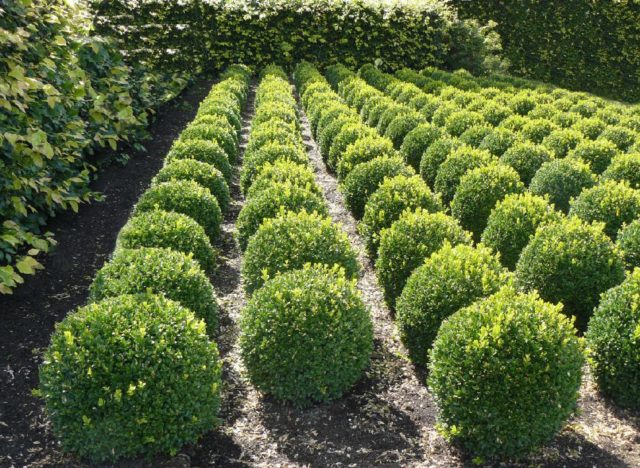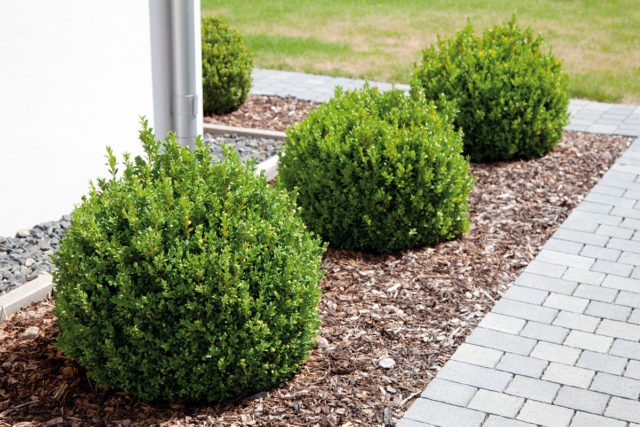Content
Feeding boxwood is one of the most important measures for caring for ornamental crops. A shrub, deprived of any of the necessary substances, changes color, loses leaves and entire branches. A healthy boxwood can live more than 500 years, remaining a bright, original decoration of the garden. But to maintain its impeccable decorative appearance, it will require regular feeding, starting from the first years of life.
Types of fertilizers for boxwood
Boxwood is able to grow in a wide variety of soils and thrives in both foggy England and the hot climate of the Mediterranean. But culture has some preferences. The evergreen shrub feels best on soils with admixtures of clay and limestone. If planting is planned in sandy soil, it is advisable to fertilize it with mature compost.
After planting, boxwood can be fed in several ways using fertilizers of various origins. The choice of products depends on the preferences of the gardener, economic feasibility and local conditions.
Mineral fertilizers
Ready-made compositions for evergreens greatly simplify caring for boxwood.It is convenient to use individual mineral fertilizers if the shrub’s need for certain elements has been established. Fertilizers can be applied throughout spring and summer. Experienced gardeners recommend completing such procedures in July.
The following ready-made preparations are most often used to feed boxwood:
- traditional potassium, phosphorus compounds (potassium chloride, superphosphate) and nitrogen fertilizers (ammonium nitrate);
- the complex preparation PETER PEAT “NPK 15-15-15” can be used at intervals of 20 days;
- for rooting boxwood (buxus) – Ecostyle Buxus-AZ, applied immediately after planting;
- growth activator, stimulating chlorophyll synthesis – AGRECOL;
- mixtures for immunity and decorativeness of evergreen crops - Actiwin, Super Master.
Organic fertilizers
Preparations of plant or animal origin can be used as fertilizer for boxwood in spring and autumn when loosening or digging. Some organic compounds also work well as mulch.
Natural compositions have the following application features:
- An infusion of bird droppings or mullein is prepared at the rate of 1 part fertilizer to 10 parts water.
- Only well-rotted organic matter harvested a year earlier is used as fertilizer.
- Fertilizing solutions are evenly poured onto the soil in the tree trunk circle, being careful not to get on the leaves and shoots. Otherwise, adult plants risk getting leaf burns, and young plants can dry out completely.
- Indoor or potted outdoor boxwoods are fed no more than once a month.
Organic fertilizers strongly acidify the soil.This effect is dangerous for evergreen plants, so the soil should be regularly returned to a neutral state. It is not recommended to use lime compounds to deoxidize the soil under boxwoods. It is better to regularly add natural substances that have the effect of additional feeding:
- fine dolomite flour – source of magnesium, calcium;
- bone meal (white) – natural nitrogen fertilizer;
- wood ash – good potassium supplement.
Substrates deoxidize the soil, without harming beneficial bacteria in the soil and the ecological balance of the site. Fine peat, humus or bark are used as mulching material.
Homemade products
All-purpose fertilizers can be made yourself from wild herbs or weeds removed from the site. Such fertilizers are harmless, effective, and contain a lot of elements and bacteria useful for boxwood.
Preparation of infusion for feeding boxwood:
- the collected weeds are randomly chopped and placed in large containers;
- fill the green mass with water at the rate of 10 liters per 1 kg of raw materials;
- cover the container with glass or film;
- Infuse the mixture for at least 5 days.
Such fertilizers are especially relevant for boxwood in spring and summer, when the plant requires the entire spectrum of nutrients, without the danger of an overdose of nitrogen or other elements.Before fertilizing, the finished herbal concentrate is diluted with soft water for irrigation in a ratio of 1:10.
Of the available natural fertilizers, wood ash is especially popular. By pollinating the soil around the boxwood with it, several effects are obtained, including prevention from infections and pests. Crushed eggshells are used as root feeding, dripping them in the root zone.
How to fertilize boxwood
There are specialized fertilizers for buxus, which can be used for open ground or applied throughout the season under tubs of plants at intervals of 10 days. But still, boxwood should be fertilized in different ways in the fall, spring, or at the height of the growing season. This is especially true for outdoor shrubs that survive frosty winters and summer heat in the open air.
How to feed boxwood in spring
If the soil on the site was well fertilized when planting, young plants may not require feeding for several seasons. But lack of nutrition can stop the already slow growth of the bush and change the color of the leaves. Shrubs that constantly do not receive the necessary substances tend to change color, turn yellow, turn brown or dry out. Therefore, from the age of 3, they begin to fertilize boxwood every spring in several stages.
At the first signs of bud awakening, you can feed the bushes with ammonium nitrate. After 2-3 weeks, fertilize the soil with a complex composition with the obligatory presence of potassium, phosphorus and nitrogen.
Before the onset of hot months, the soil around the boxwoods should be mulched using peat. This technique will reduce moisture evaporation, keep the soil loose, and further enrich the nutrition of the bushes. The substrate is laid in a small layer in the tree trunk circle, without touching the trunk.Otherwise, the trunk, sprinkled with mulch, tends to rot. You can pre-spray ash, dolomite or bone meal under the peat layer, depending on the needs of the boxwood.
Signs of a lack of elements by changes in leaf color:
- magnesium deficiency – appearance of a brown tint;
- nitrogen deficiency – yellowness in the lower part of the bush or bronze tint of leaves;
- general soil depletion – pallor of color, discoloration.
In the middle of the season, experienced gardeners recommend fertilizing only if the condition of the bushes is alarming. It is advisable to fertilize boxwood in the summer with natural biological compounds.
How to feed boxwood in the fall
Autumn care is aimed at successful wintering of bushes. Therefore, starting from mid-summer, nitrogen fertilizing, including organic matter, is completely excluded. It is no longer necessary to stimulate the growth of green mass at this time, otherwise the young growth will not have time to mature and will freeze out in the winter.
Feeding boxwood by autumn should consist of phosphorus and potassium compounds. Experienced gardeners advise refraining from applying fertilizers after September. The last feeding of the season for boxwood should be potash (potassium salt or potassium magnesia), which will speed up the ripening of shoots and prepare the plant for cold weather.
Before frosts, moisture-charging watering must be carried out. Abundant moisture in the fall helps boxwood branches and leaves survive frosts. A few days after abundant moisture, the soil is mulched.
How to properly feed boxwood
In order for the application of fertilizers to bring only benefits and allow you to grow a beautiful ornamental bush, and not cause harm, you should follow several rules:
- any fertilizing begins only after the seedlings are completely rooted;
- after each cutting, boxwood requires increased feeding (preferably with complex compounds for evergreens);
- It is advisable to sprinkle mineral fertilizers evenly around the bushes in dry form - the concentrated solution burns the roots;
- Liquid fertilizers are applied only after watering, on wet soil.
In summer, foliar irrigation can be carried out by spraying weak fertilizer solutions on the leaves. The procedure is carried out only in the evening or in cloudy weather to avoid chemical and sunburn of the leaves.
Conclusion
Feeding boxwood seems like a complicated science only at first glance. Having carried out one annual cycle of caring for ornamental bushes, even a novice gardener can simply repeat it in subsequent seasons. For a healthy, normally developing bush, spring and autumn feeding are the main and often sufficient procedures. The rest of the time you need to monitor the condition of the boxwood and respond to its needs in a timely manner.











